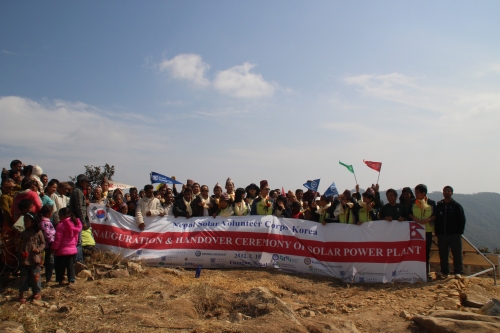Koreans have brought warmth and light to a remote Nepali village by installing solar power, as well as the country’s first ondol heating system.
The mountain community of Thingan used to plunge into darkness at sundown. But now village residents are enjoying brighter, warmer nights thanks to photovoltaic technology installed as part of the 10 million-rupee ($125,200) project.
A 26-person expedition, including professors and students from three Korean universities, visited the village in Nepal’s Makawanpur region to install a solar power lighting system.
The 5 kilowatt photovoltaic system included solar panels, inverters and charge controllers as well as 20 km of wiring for transmission lines and homes throughout the village.
Four LED lamps were installed in each home, with each household set to pay a small monthly user fee for the electricity. Hi-tech photo sensor switches were also installed on street lights to automatically turn them on at dusk and off when the sun rises.
The Korean team designed and funded the project, while villagers constructed a building to house the batteries that will store the energy harnessed from the sun. The structure includes additional rooms to be rented to locals for poultry farming.
The green technology was provided by Korean universities and the government through Korea’s National Research Foundation. Korean companies also supplemented volunteers’ personal donations, and Samsung donated 290 hi-tech LED lights.
The volunteers also installed Korean-style ondol in some homes ― the first time the under floor heating technology has been used in Nepal.
 |
The Nepal Solar Volunteer Corps celebrate their work in the remote Nepali village of Thingan. (Nepal Solar Volunteer Corps) |
The volunteer team including South Korean professors Ahn Sung-hoon of Seoul National University, Caroline S. Lee of Hanyang University and Song Chul-ki of Gyeongsang National University and their students traveled to Nepal for the project this February. The Nepal Solar Volunteer Corps were joined by Professor Ramesh K. Maskey and other volunteers from Kathmandu University for the project, with around 300 people helping in total.
The Korean volunteers also provided $200 in scholarships for ten poor village students. They also donated 700 books, a projector and laptops to a newly built library.
Binayak Bhandari, a Nepali engineering Ph.D. student at Seoul National University coordinated the trip.
“We had science camp in a local high school where we donated science kits, musical instruments, cookies, soccer balls and gifts to more than 250 students of the school,” Bhandari said.
“Additionally, for the first time in the history of Nepal, we made a prototype of the ondol traditional Korean floor heating system for the villagers.”
Nepali local development officer Yuvaraj Subedi said that solar technology was key for development, while Ahn, the director of the volunteer corps, said that the villagers’ participation had helped achieve the “near-impossible” project.
Villagers helped to construct the power plant building and provided 69 electric poles for the transmission lines. One local, Hira Bahadur Ghale, donated land for the project site.
“The electrification of the village is important because it will support education and local cottage industries,” said Nepali Charge de Affaires to Korea Rajaram Bartaula. “Through the electrification, the village not only get light but also the be connected with the outside world.”
The volunteer corps previously completed similar smaller projects at Rimche and Lama Hotel villages in Nepal’s Langtang National Park last year.
By Kirsty Taylor (
kirstyt@heraldcorp.com)








![[Today’s K-pop] Blackpink’s Jennie, Lisa invited to Coachella as solo acts](http://res.heraldm.com/phpwas/restmb_idxmake.php?idx=644&simg=/content/image/2024/11/21/20241121050099_0.jpg)